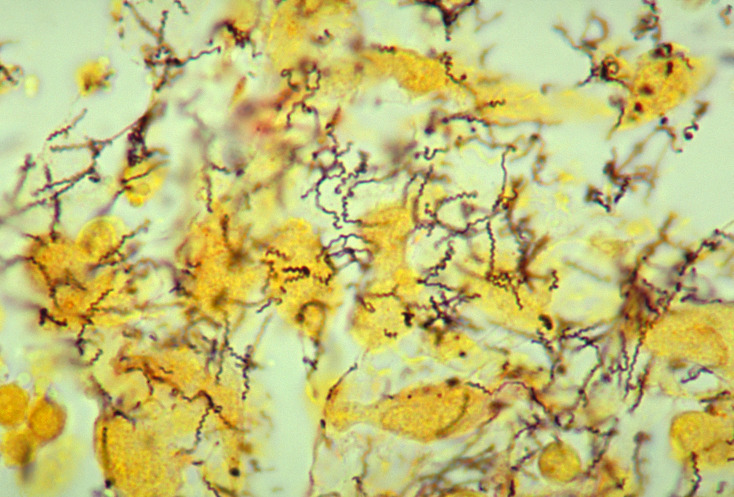Playlist
Show Playlist
Hide Playlist
Infections by Bacteria in Different Groups: Eubacteria, Actinomycetales and Spirochaetes
-
Slides Overview of Different Classes of Microorganisms.pdf
-
Download Lecture Overview
00:01 So pathologic features - once we've kind of - can we hold them into gram positive, gram negative, and cocci and bacilli, or spirochetes or branched, then we can talk about some of the pathologic features. 00:16 So because they tend to be extracellular - some can be facultative intracellular, but the ones that are extracellular will tend to induce an acute inflammatory infiltrate. 00:27 That is to say neutrophils, are able to be good fighters to deal with extracellular eubacteria. 00:35 So you can get an abscess, you can see actually the abscess in the top panel which is where we had a single bug or a little cluster of them, end up in the kidney, and we've destroyed, as a result of the abscess formation, we destroyed that portion of the kidney, and we're just looking also at the abscess on the skin from staphylococcus aureus. 00:57 So they tend to be, when they're extracellular, acute inflammatory infiltrates and abscesses. 01:05 Okay, let's get into the Actinomycetes. 01:07 Again, recall this is in order, this is not a file I'm working, they've been in order and Actinomycetes are for the most part, extracellular bacteria. 01:17 They are gram positive and they branch, so they look a little bit like fungus, but they're gram positive which fungus will not be. 01:24 An example shown here is Nocardia and Corynebacterium and there are others in that category. 01:31 Also in the Actinomycetales are the mycobacteria. 01:36 This is the family of that particular order, and the mycobacteria are facultative intracellular pathogens, so they can be switch hitters, they can live inside the cell or outside the cell. 01:48 Because they can be a switch hitter, they can be very difficult to eradicate, they just hanker down within a cell. 01:56 We identify them through an acid-fast stain. 02:00 So this is a particular stain that we dump onto the slide and if the bacterial cell wall of the mycobacterium picks it up and will not wipe it away when we had acid, it's said to be acid fast. 02:18 And that arrow is pointing to the one lone microorganism, the one lone tubercle bacillus that's present on that field, that's a little thin rod. 02:29 We affectionally refer to them as red snappers, and that pink stain is the acid-fast carbol fuchsin stain. 02:38 The various mycobacteria include tuberculosis, leprosy, and an opportunistic infection called mycobacterium avium intracellulare, but there are several others. 02:50 So the pathologic features. 02:52 So the Actinomycetes, because they are extracellular, will tend to induce acute inflammation and abscesses, just like the eubacteria that are extracellular. 03:02 On the other hand, mycobacteria, because they can have that facultative intracellular capacity, will tend to induce chronic and granulomatous inflammation. 03:12 They are actually remarkably difficult to eradicate even with an intact immune system and what we tend to do is wall them off within granulomas so that we have a bunch of activated microphages serving the sentries around this prison in the middle of which there's two or three mycobacteria that are still alive, but all we can do jail them, we can't completely eliminate them. 03:41 Finally, we get to the spirochetes, Phyla. 03:45 These are truly corkscrew-shaped organisms. 03:50 They don't stain with gram-stain actually. 03:52 They stain with a silver-stain and will stain black when we do that. 03:56 They are extracellular, so they will be amenable to antibody and to neutrophil-mediated destruction, and include bugs such as syphilis and helicobacter pylori, which is the cause of peptic ulcer disease. 04:12 They can also be facultative intracellular such as borrelia, which is the cause of lime disease. 04:18 Their transmission can be venereal, syphilis. 04:22 It can be fecal-oral, helicobacter pylori. 04:25 Or it could be arthropod born, borrelia; so they can have a variety of ways of getting into us. 04:30 Some of the pathologic features. 04:34 I'm showing you a consequence of tertiary syphilis. 04:38 Syphilis is also called lues, so if you are at bedside you don't want your patient to suspect you're talking about syphilis, you can call it luetic disease. 04:48 This is due, in this particular case, the Treponema pallidum. 04:51 This particular treponeme syphilis, has a tropism for the endothelium typically in the ascending aorta, and they will bind via fibronectin to that location. 05:07 When the immune system recognizes that that they are there. 05:13 It will set up a chronic inflammatory response directed against the small arterioles, the vasa vasorum, and that inflammatory response try to eliminate the syphilis spirochete will cause substantial damage which will cause irreversible injury to the vasa vasorum vessels causing an obliterative endarteritis, that will lead to lose of blood supply to that part of the aorta and as a result of that, the aorta undergoes degeneration and will expand into a syphilitic aneurysm. 05:50 So typically, ascending aortic aneurysms classically can be associated with tertiary syphilis and that's what's just demonstrated with the radiographic image and the gross image on the right hand side.
About the Lecture
The lecture Infections by Bacteria in Different Groups: Eubacteria, Actinomycetales and Spirochaetes by Richard Mitchell, MD, PhD is from the course Host–pathogen Interaction.
Included Quiz Questions
What is the stain used to identify a Mycobacterium?
- Acid-fast stain
- Congo red stain
- Gram stain
- Papanicolaou stain
- Thioflavin S stain
Which of the following organisms is an example of a spirochete?
- Treponema pallidum
- Actinomyces israelii
- Candida albicans
- Nocardia brasiliensis
- Streptomyces scabies
Customer reviews
5,0 of 5 stars
| 5 Stars |
|
5 |
| 4 Stars |
|
0 |
| 3 Stars |
|
0 |
| 2 Stars |
|
0 |
| 1 Star |
|
0 |




